PinotFile: 8.21 September 8, 2010
|
Brogan Cellars: “Good, Better, Brogan”Margaret (“Margi”) Williams Wierenga was a teenager in the late 1970s when her father, Burt Williams, of Williams Selyem fame, began to make his first wines in a bathtub in a basement below the family’s garage. By 1984, Burt Williams and Ed Selyem had launched the Williams Selyem label (from 1981 to 1983 they produced wine under the Hacienda Del Rio label) and moved into a rented garage on River Road in the small Russian River Valley town of Fulton. Working there under the wings of Burt, Margi developed her early winemaking skills, becoming a full-fledged part of the winemaking team when the winery was relocated to the Allen Vineyard property on Westside Road in Healdsburg. She also honed her talent at the nearby Hop Kiln Winery under the tutelage of winemaker Steven Strobel. Burt Williams was a burly vintner who favored colorful sport shirts with suspenders, was blessed with a superb palate and an uncanny and self-taught sense of how to vinify Pinot Noir. Margi shared his hearty laugh and winemaking acumen, and when Williams Selyem was sold in 1998, she started her own label, Brogan Cellars, named after her paternal grandmother. The new project had a sense of déjà vu, since the start up reminded of the early days of the Williams Selyem Winery. Margi noted, “It was a bootstrap business run on a lean $75,000 startup budget.” Margi’s father was prohibited from advising her under the non-compete clause included in the sale of his winery so she made her stamp alone is on the Brogan Cellars wines. Margi is pictured below with her mother, Jan, at the 2007 Anderson Valley Pinot Noir Festival.
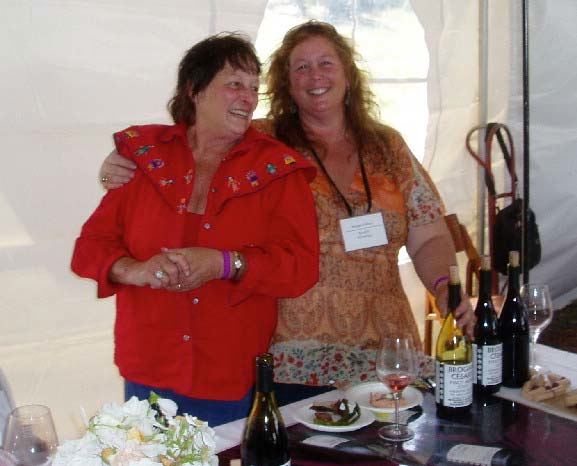 Margi crafted her first Pinot Noirs, a 1998 Brogan Cellars Russian River Valley Pinot Noir and a 1998 Brogan Cellars Lone Redwood Ranch Russian River Valley Pinot Noir, working out of a cramped converted garage. Margi’s spouse, Mike, who owns a refrigeration company, used his repairer skills to rig her winemaking equipment. Like her father, she knew that Pinot Noir required delicate handling and constant vigilance in the winery, leading her to employ the same laborious hands-on winemaking techniques that Burt had fostered. She used much of the same rudimentary winemaking equipment that Burt used out of necessity (for many years, Williams Selyem had little money to fund their operation), such as a tiny crusher and old dairy vats for fermentation. Located in Dry Creek Valley, the winery’s barrel-aging room, office and tasting area were housed in a 800-square-foot garage with the winemaking equipment located under the adjacent car port. In 2006, the winemaking operation was moved to property the Wierengas own in Hopland, 30 miles north of Healdsburg, and the leased garage in the Dry Creek Valley was retained for use as case storage, an office and a tasting room. In 2004, Margi and Mike’s son, James Cobb, joined Brogan, adding a third generation to the family winemaking tradition. Customers too have become family at Brogan Cellars, as many volunteer along with family friends each year to assist with the crush, a tradition that has continued from the winery’s beginning. Perhaps the spirit at Brogan Cellars can best be summed up by a “Brogan Slogan” contest held several years ago. Some of the best suggestions were: “Braggin’ ‘Bout Brogan,” “Good, Better, Brogan,” “Break Out The Brogan,” “How Does Your Brogan Grow?” and “Red, White and Brogan. An All-American Wine.” Winemaking at Brogan Cellars is straightforward. The percentage of whole cluster used depends on several factors associated with the vintage including, according to Margi, “The look of the clusters when they are picked and my prior experience with the vineyard.” Whole cluster inclusion can be as much as 30% or as little as none. No additives are used. Indigenous yeast fermentations are carried out in used dairy tanks (cut in half) and the juice is pressed off at dryness. The Pinot Noirs are usually aged about 11 months in approximately 50% new Francois Frères oak barrels, and are bottled unfiltered. During her years at Williams Selyem, Margi was able to develop valued contacts among the premium winegrowers in the region, so when she launched her own winery, she had reputable grape sources in place. Her consistent grape suppliers have included Lingenfelder, Hansen and Buena Tierra vineyards in the Russian River Valley, Summa Vineyard in the Sonoma Coast, and Morning Dew Ranch (Burt Williams’ vineyard) in the Anderson Valley. Pinot Noir is the featured wine at Brogan Cellars, but occasionally Margi has crafted Chardonnay, Sauvignon Blanc, Semillon, Merlot, Syrah and Zinfandel. The Pinot Noir bottlings have varied from year to year, with both appellation wines (a Russian River Valley bottling is constant, and a Sonoma Coast and Anderson Valley Pinot Noir have been produced in the past), and vineyard-designate wines offered through a spring and fall release. The venerable Buena Tierra Vineyard Pinot Noir (“sex in a glass”) is the consistent star in the lineup and I have written about this vineyard in the past (www.princeofpinot.com/article/524/). The annual production of less than 2,000 cases is sold primarily to a faithful mailing list. I recently dove into my cellar and sampled multiple Brogan Cellars Pinot Noirs from the 2003 to 2008 vintages. Unfortunately, I have drank up most of my 2003 and prior vintage wines except for a few magnums. The wide palate of individual offerings have commendable distinctiveness, reflecting their terroir and the vagaries of each vintage. Margi obviously lets the grapes do the talking. After tasting several vintages, I can easily tell Pinot Noir from Buena Tierra Vineyard from that of Lingenfelder Vineyard from that of Morning Dew Ranch, and can detect subtle vintage differences among wines from the same vineyard. Alcohols run the gamut from a low of 13.0% to a high of 15.3% and the offerings range from big-boned to elegant in style. The 2004 and 2005 vintage Pinot Noirs have aged beautifully and there is no hurry to drink them now. The 2006 vintage wines were derided by the press but were my favorites. Margi told me, “The yields were larger than normal and not all wines got whole cluster due to space limitations. I knew the vintage would turn out to be one of my favorites when the grapes were in the tank. My customers who had faith got some beautiful wines.” The 2007 and 2008 vintages need a few more years of bottle age. Margi advises her customers to bottle age her wines and decant if they choose to open them within a few years after release. Margi held prices between 2001 and 2005, succumbing to a small increase beginning in 2006 due to rising grape prices and costs of production. Some wines have been offered periodically as futures at a significant reduction in price. The 2008 vintage was challenging as has been widely publicized. Margi notes that her Anderson Valley Pinot Noirs were smoke affected but finds the effect is subtle. She used no new oak and left the wines in barrel longer to minimize the smoke effect. Margi said, “The wines from Anderson Valley reflect the vintage year and the smoke added to the terroir. Drink the wines with salmon and enjoy what each vintage has to offer even if it is not heralded as a great year. The 2006 vintage proved that.” Winemakers and wine writers tend to be more critical in evaluating the 2008 Anderson Valley wines because they are looking for smoke. Margi’s experience has been that 80% to 90% of consumers don’t notice any smoke affectation in her Anderson Valley Pinot Noirs. Recently, a European wine writer and some German importers tasted the 2008 Brogan Cellars Jan’s Reserve My Father’s Vineyard Anderson Valley Pinot Noir and deemed it a favorite. I highly recommend you arrange a tasting of Brogan Cellars wines with Margi when you are in the Russian River Valley region. Tasting is offered by appointment at 3232B Dry Creek Road in Healdsburg. (707-473-0211). Join the mailing list at www.brogancellars.com. Margi offers magnum formats for nearly all the Pinot Noir offerings from recent vintages. Older vintages are available for sale. In 2008, production was 75 cases or less except for the Russian River Valley Pinot Noir, the Hansen Vineyard Pinot Noir and the Sonoma County Pinot Noir (not reviewed) bottling.
2008 Brogan Cellars Russian River Valley Pinot Noir 13.5% alc., $50. · Moderate garnet hue in the glass. Very intense perfume of cherries with a hint of sandalwood and oak. Delicious cherry pie core with a touch of tar and herbs. Discreetly rich with restrained tannins and a refreshing finish. The most forward wine in the 2008 lineup. Very good.
2008 Brogan Cellars Russian River Valley Reserve Pinot Noir 13.5% alc., $75. A blend of all Russian River Valley vineyard designates. · Aromas of black cherries, spice, sandalwood and prominent toasted oak. Plenty of fruit at the core, but dominated by flavors of oak and ash. Silky soft on the palate with fine tannins. Will surely improve over time in the bottle with more integration of the oak, although an opened and re-corked bottle was not any better the next day. Decent.
2008 Brogan Cellars Hansen Vineyard Russian River Valley Pinot Noir 13.9% alc., $65. · This wine is not ready for prime time yet. The fruit is simply too shy and oak steals the limelight. Like all Margi’s wines, the silky soft texture is very appealing. I would revisit this wine in a few years. Decent.
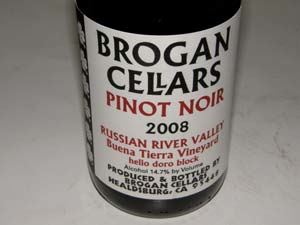 2008 Brogan Cellars Buena Tierra Vineyard Helio Doro Block Russian River Valley Pinot Noir 14.7% alc., $90. May be the last designated Helio Doro Block as Margi is using fruit from other parts of the Buena Tierra Vineyard and may be doing a vineyard blend in the future. · Bright aromas of Bing cherries, strawberries and baking spices. Strikingly intense and flavorful red cherry and berry fruits with hints of brown spices, cherry cola and Red Vines that linger on the pleasing finish for over 30 seconds. Soft in the mouth with impressive finesse and sensuality. This wine has the whole package and is deserving of the title, “Sex in the glass.” Buena Tierra is one of California’s greatest Pinot Noir vineyards, consistently offering a Grand Cru drinking experience. A certain All-American this year.
2008 Brogan Cellars Morning Dew Ranch Anderson Valley Pinot Noir 13.9% alc., $50. · Deeply colored in the glass. Appealing aromas of black cherries and dark berry jam with a hint of tobacco smoke. Tasty core of dark stone fruits with a faint accent of tar in the background. Nicely composed with a silky mouth feel and gossamer tannins. Good.
2008 Brogan Cellars My Father’s Vineyard Margi’s Block Anderson Valley Pinot Noir 14.0% alc., $65. · Shy fruit aromas with noticeable scents of cigar and ash. On the palate, the sweet and smoky black cherries plums and blackberries are framed by bright acidity and pillowy tannins. Think grilled fruit from the barbecue. Hard for me to get by the smoke affect. Decent.
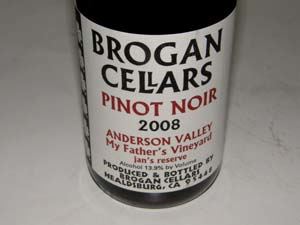 2008 Brogan Cellars My Father’s Vineyard Jan’s Reserve Anderson Valley Pinot Noir 13.9% alc., $65. A blend of clones from Morning Dew Ranch, named in honor of Margi’s mother. · Moderate reddish-purple color in the glass. Shy, but pleasing aromas of darker stone and berry fruits. Nicely crafted and very harmonious with discreet flavors of darker red fruits including pomegranate, with lively acidity, mild tannins and a soft, finesse-laden texture. There is a faint tarry, smoke taste in the background. Good.
Production of Pinot Noir in 2007 was half of the that made in 2006.
2007 Brogan Cellars Russian River Valley Pinot Noir 14.1% alc., $50. · Panoply of aromas including dark berries, dates, underbrush, cut flowers and a touch of barnyard. Tasty essence of dark red cherries and berries with a savory bent. Still noticeably oak infused with firm tannins and lively acidity on the finish. Needs more time to come together. Decent.
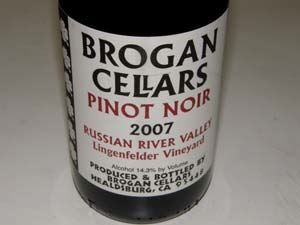 2007 Brogan Cellars Lingenfelder Vineyard Russian River Valley Pinot Noir 14.3% alc., $65. · Moderately dark reddish purple color. Reticent aromas of dark fruits and oak. A full-on palate of mixed berry fruits with plenty of tannin and a cola and citrus note in the background. A husky wine with an impressive core of fruit that needs time for integration of the tannin. Good.
2007 Brogan Cellars Morning Dew Ranch Anderson Valley Pinot Noir 13.6% alc., $50. · Like the name of the vineyard implies, this wine smells of fresh morning air with shy red berry fruits in the background. Rather austere and crisp in style with tart cherry, cranberry and pomegranate flavors. Good.
2006 Brogan Cellars Russian River Valley Pinot Noir 14.8% alc., $45. Aged 11 months in 50% new French oak barrels. · A cherry bombast in the glass. Mildly syrupy and thick on the palate with flavor bites of spice and anise adding interest. The tannins have melded and lively acidity lifts the finish. Prototypical Russian River Valley Pinot. Can drink now. Good.
2006 Brogan Cellars Russian River Valley Reserve Pinot Noir 15.1% alc., $65. · Moderately light reddishpurple in color with a slight orange tinge to the rim in the glass. The wine shows unappealing scents of cooked fruit, herbal oak and leather sole. The ripe black cherry, cassis, and sassafras flavors are flat. The loss of color, aroma and flavor indicate a prematurely oxidized wine. An unsatisfactory bad bottle.
2006 Brogan Cellars Sonoma Coast Pinot Noir 14.2% alc., $45. Aged 11 months in 50% new French oak barrels. · Moderately light reddish-purple color in the glass. Lovely nuanced aromatic profile featuring earthkissed berries, bay leaf, spice and oak. Soft and elegant on the palate, with flavors of dark red cherries and berries, gossamer tannins, and a refreshingly bright finish. Good.
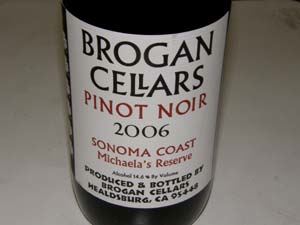 2006 Brogan Cellars Michaela’s Reserve Sonoma Coast Pinot Noir 14.6% alc., $110. The last Brogan Cellars Pinot Noir from Summa Vineyard. Named for Margi’s granddaughter born in 2006. Aged 15 months in 50% new French oak. Margi notes, “I am counting on aging a few cases at least 21 years for my granddaughter.” · Moderately intense reddish-purple color in the glass. A marvelously fruity nose brings you to attention. Delicious layers of intense red and black fruits fan out in the mouth, caressed by mild, firm tannins and framed by a bright citric note. The texture wraps you in silk pajamas as the dreamy finish sails along. A classy wine that lets you know it is a Reserve.
2006 Brogan Cellars Lingenfelder Vineyard Russian River Valley Pinot Noir 15.3% alc., $60. From a Pommard clone block. Aged 11 months in 50% new French oak barrels. · Moderate reddish-purple color in the glass. Opens slowly in the glass, revealing intense crushed berry, black cherry and dark chocolate aromas. Rich and toasty ripe dark fruits fill the mouth with pleasure. The tannins have melded and the wine is all silk and satin. The intense fruit, prominent oak and high alcohol all come together in harmony. Very good.
2006 Brogan Cellars Hansen Vineyard Russian River Valley Pinot Noir $60. A new vineyard source in 2006. Aged 11 months in 50% new French oak barrels. · Moderately light in color with an orange cast to the rim of the glass. Appealing aromas of strawberries and cherries which are slightly roasted. Light on its feet and easy to drink, the red fruit flavors are set off by a subtle note of Madera. This wine is showing slight premature oxidation. Good.
2006 Brogan Cellars Buena Tierra Vineyard Helio Doro Block Russian River Valley Pinot Noir 14.5% alc., $80. Aged 15 months in 50% new French oak barrels. · The aromas of fresh black cherries, Herbs de Provence and warm brioche draw you into the glass. Delicious flavor of berry jam on toast with amazing intensity and staying power on the long, long finish. Very smooth in the mouth and drinking beautifully now. This wine never disappoints. Very good (+).
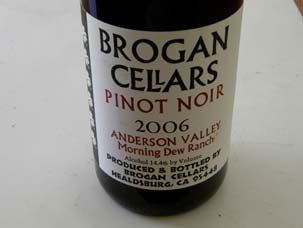 2006 Brogan Cellars Morning Dew Ranch Anderson Valley Pinot Noir 14.6% alc., $45. Aged 11 months in 50% new French oak barrels. · Moderate reddish-purple color in the glass. The aromas of hard cherry and berry candy remind me of my childhood. Scents of pine pitch and sage add interest. Delicious and intense core of red fruits with a confected note, hints of red licorice and root beer, all framed in mild firm, dry tannins. Very harmonious with a notable persistence of fruit flavors on the pleasing finish. Very good.
Other bottlings in 2006 not reviewed: My Father’s Vineyard Margi’s Block Anderson Valley Pinot Noir and My Father’s Vineyard Shula’s Pond Anderson Valley Pinot Noir.
2005 Brogan Cellars Russian River Valley Pinot Noir 14.5% alc., $45. Aged 11 months in 50% new French oak barrels. · Attractive perfume of Bing cherries, baking spices and fennel. Red-fruited featuring cherries and pomegranates with a side car of cola, graham, bacon and citrus. On the lighter side with soft tannins. Tends to fade over time in the glass. Drink up. Good.
2005 Brogan Cellars Lingenfelder Vineyard Russian River Valley Pinot Noir 13.9% alc., $55. · An earthy, savory wine with plenty of tasty black raspberry and black plum fruit and a dash of allspice and oak reflecting its Pommard and Martini clonal origins. The mouthfeel is rich and pleasing with well defined tannins holding the fruit in check. A seamless wine that has staying power for over an hour in the glass. Very good (+).
2005 Brogan Cellars Sonoma Coast Reserve Pinot Noir 13.9% alc., $60. Sourced from Summa Vineyard. Aged 11 months in 50% new French oak barrels. · Terrific aromas of cherry pie and baking spices. The wine attacks the palate with a big burst of luscious black cherry fruit augmented with subtle earth and oak notes. A solid wine that picks up intensity and interest in the glass. Smooth and charming, this Pinot is refined and balanced. Very good.
2005 Brogan Cellars My Father’s Vineyard Anderson Valley Pinot Noir 13.0% alc., 150 cases, $60. Aged 15 months in 50% new French oak barrels. This vineyard has grafts from Rochioli Vineyard. · Dark reddishpurple hue in the glass. Alluring scents of wild berries, brown spice, brioche and sawn wood. Very subtle possibility of cork taint (second bottle not available). Intense and persistent cherry and berry fruits tasting like jam on toast. Plenty of acidity on the refreshing finish. Good.
Other bottlings in 2005 not reviewed: Buena Tierra Vineyard Helio Doro Block Russian River Valley Pinot Noir.
2004 Brogan Cellars Russian River Valley Pinot Noir 15.1% alc., 235 cases, $45. Aged in 45% new French oak barrels. Unfined and unfiltered. · Darkly colored. Aromas of black cherries, wild berries and mocha java draw you in. Rich and vivid flavors of cassis and black plums with a touch of anise, spice and dark chocolate. The tannins are soft and well integrated. A hedonist’s delight with a slight syrupy texture but not cloying or jammy. Impressive persistence on the finish. Very good.
2004 Brogan Cellars Benovia Russian River Valley Pinot Noir 14.6% alc., 50 cases, $50. Sourced from the Cohn Vineyard used by Williams Selyem for many years. Aged 11 months in 50% new French oak barrels. · On the nose there are pleasing aromas of mixed red berries with a subtle green note. The tasty core of red cherries and berries linger on the pleasing finish. Soft and elegant, veering to the light side but quite enjoyable. Good. Note: this was a second bottle - the first bottle sampled was corked.
2004 Brogan Cellars Lingenfelder Vineyard Russian River Valley Pinot Noir 14.8% alc., 75 cases, $48. Aged 11 months in 50% new French oak barrels. Blend of Pommard and Martini blocks. · Moderate reddishpurple color in the glass. The nose is highlighted by purple fruits with a dash of soy, tea and purple roses. Very tasty big-boned core of cassis and black plum flavors with oak playing a supporting role. Nicely composed with a smooth texture, flannel tannins and a big fruit-driven finish. Drinking perfectly now. Very good.
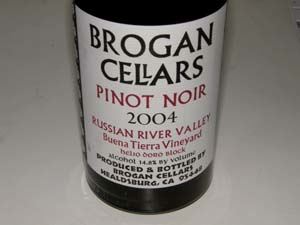 2004 Brogan Cellars Buena Tierra Vineyard Helio Doro Block Russian River Valley Pinot Noir 14.8% alc., 220 cases, $75. Aged in 75% new French oak barrels. · Lightest in color of the 2004 wines sampled. Lovely perfume of Bing cherries with a dash of oak and leather. Flat-out delicious with vibrant flavors of cherries, baking spices and sandalwood. Sleek, silky and showing all the style and grace one could ask for.
2004 Brogan Cellars Summa Vineyard Young Vines Sonoma Coast Pinot Noir 14.1% alc., 150 cases, $60. · Deep, dark reddish purple color in the glass. Earthy and savory with scents of grilled plums and mushrooms with notes of old cask and smoke. Exotically flavored dark fruit with accents of anise and black olive. Still has notable tannins and considerable life ahead. A distinctive wine that holds your interest. Good.
Other bottlings in 2004 not reviewed: Anderson Valley Pinot Noir, My Father’s Vineyard Anderson Valley Pinot Noir, Summa Vineyard Sonoma Coast Pinot Noir.
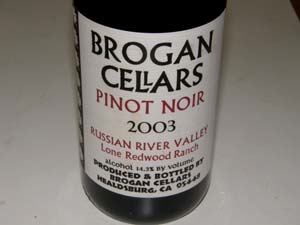 2003 Brogan Cellars Lone Redwood Ranch Russian River Valley Pinot Noir 14.3% alc., $50. Unfined and unfiltered. · Moderately dark reddish-purple color with a slight orange hue to the rim. Bright black cherry aroma with hints of red licorice and exotic woods. Very tasty black cherry essence with tobacco and cola in the background. The tannins are very soft and the bright acidity frames the fruit beautifully. A great older Pinot that has held up nicely. Very good (+).
Older Vintages 2002: California Pinot Noir, Russian River Valley Pinot Noir, Lone Redwood Ranch Russian River Valley Pinot Noir, Summa Vineyard Sonoma Coast Pinot Noir, Summa Vineyard Young Vines Sonoma Coast Pinot Noir, Buena Tierra Helio Doro Block Russian River Valley Pinot Noir 2001: Russian River Valley Pinot Noir, Lone Redwood Ranch Russian River Valley Pinot Noir, Buena Tierra Helio Doro Block Russian River Valley Pinot Noir. 2000 Russian River Valley Pinot Noir, Russian River Valley Reserve Pinot Noir, Olivet Lane Vineyard Russian River Valley Pinot Noir, Lone Redwood Ranch Russian River Valley Pinot Noir. 1999: Russian River Valley Reserve Pinot Noir, Lone Redwood Ranch Russian River Valley Pinot Noir 1998: Russian River Valley Pinot Noir, Lone Redwood Ranch Russian River Valley Pinot Noir
Clos Saron: Distinct Pinot Noir from an Unlikely RegionGideon Bienstock, an experienced winemaker, and his wife Saron Rice, have developed a small outpost for Pinot Noir in the northern limits of the Sierra Foothills AVA of Northern California. Gideon is the winemaker for the famed nearby Renaissance Vineyard & Winery and Saron is well-versed in viticulture. Together, they set out over ten years ago to transcend all the preconceived notions about winegrowing possibilities in the Sierra Foothills. Located on the western slopes of the Sierra Nevada, the Sierra Foothills is a sprawling AVA of 2.6 million acres that includes Amador, Calaveras, El Dorado, Mariposa, Nevada, Placer, Yuba and Tuolumne counties. There are five sub-AVAs, including El Dorado, Fair Play, Fiddletown, North Yuba and Shenandoah Valley (refer to map on page 8). The AVA is known for hot days and very cool nights with the extent of the diurnal range dependent on the elevation. The soils are decomposed granite and finely crushed volcanic ash which provide good drainage. Nutrients are sparse so vine roots are forced deep to seek out water and nourishment. The well-over 100 wineries in the Sierra Foothills AVA have had proven success with warm climate varieties including Zinfandel, Syrah, Petite Sirah, Cabernet Sauvignon and Sauvignon Blanc. The earliest vines were planted during the California Gold Rush of the 1800s, and because of the relative isolation of the region from other California wine growing areas, the vines have been protected from phylloxera and other insults. The result is that the Sierra Foothills AVA contains some of California’s oldest producing vines. Pinot Noir is not a variety that comes to mind when you think about the Sierra Foothills, but surprisingly, this AVA has a history with Pinot Noir dating back to the 1880s. According to John Winthrop Haeger (North American Pinot Noir), Eugene Hilgard of the University of California directed the planting of experimental vineyards in the foothills of the Sierra Nevada near the town of Jackson in Amador County. More than 150 grape varieties including Pinot Noir were established at the Jackson Station. The project was abandoned in 1903 as the experiment proved untenable. Some surviving Pinot Noir vines were discovered in 1963 and these so-called Jackson clones have remained of interest because they show some resistance to cold, having adapted to the frigid winters in the Sierra Nevada. Despite that, the Jackson clones have never been widely planted. The University of California at Davis classified the Jackson clones as UCD 1, UCD 9, UCD 16 and UCD 29. According to Haeger, “The Jackson clones have the distinction of being the earliest documented imports of Pinot Noir still under cultivation in North America, having unarguably been imported before 1890 - and perhaps considerably earlier.” Undaunted by the lack of historic success with Pinot Noir in the Sierra Foothills, Gideon and Saron (pictured below at Pinot Days) have taken on the challenge. What they started, and what they have accomplished to date, is a remarkable story. At Clos Saron, they only work with organic fruit and farm all their grapes, including sourced grapes. They specialize in Pinot Noir and non traditional blends of other red and white varieties. Annual production is around 800 cases, with Pinot Noir accounting for half the offerings and special cuvèes making up the other half.
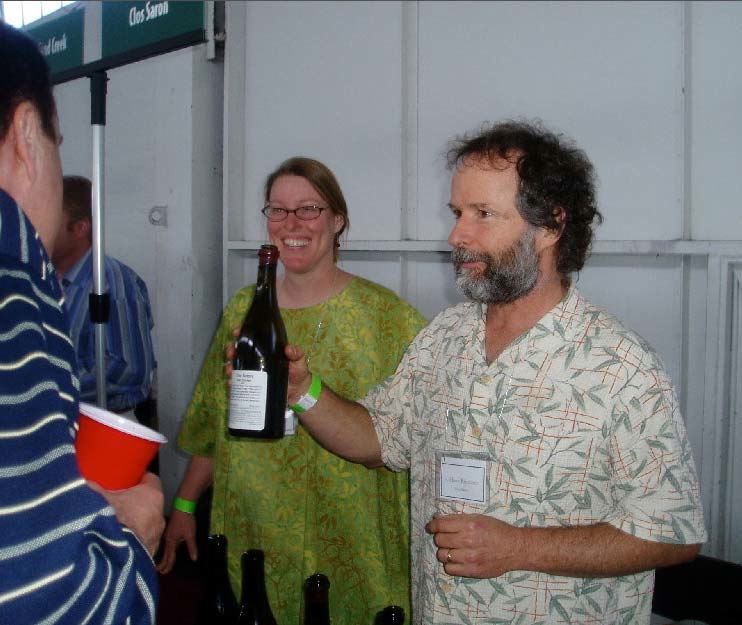
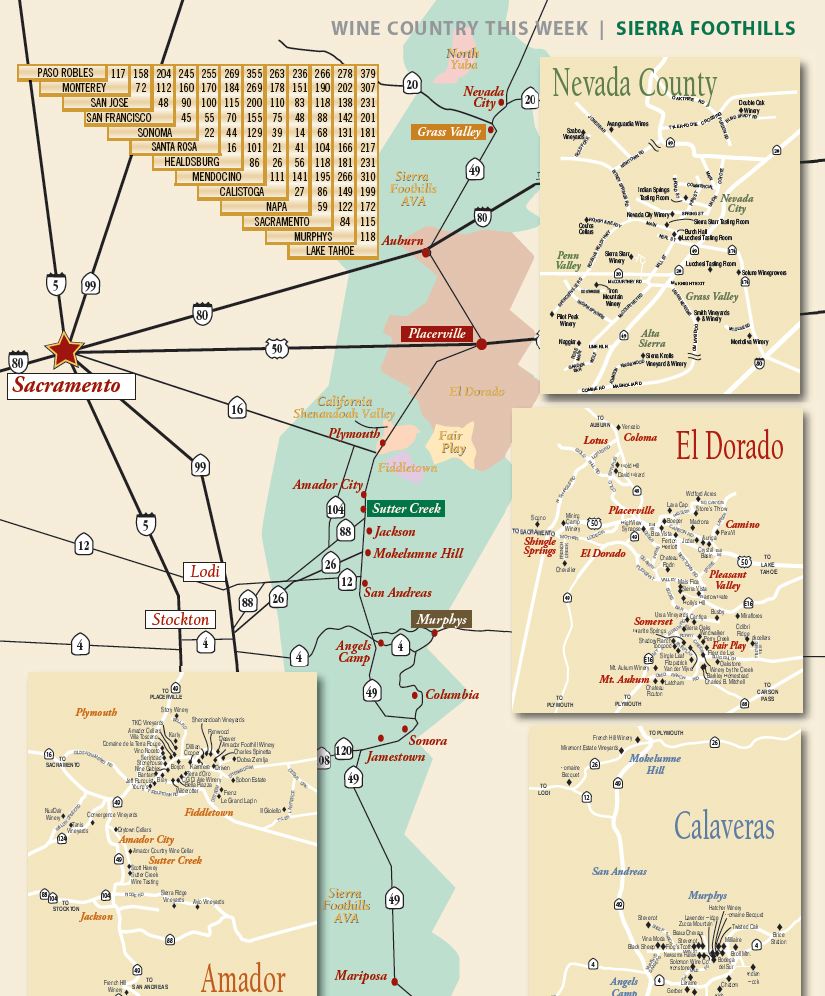 The heart of Clos Saron is the small Home Vineyard adjacent the family’s home and tiny winery in the Oregon House Valley of Yuba County. The first half acre of Cabernet Sauvignon and Merlot vines were originally planted on this gentle, north east facing forested slope in 1980. This old block was planted to 6’ x 8’ spacing and these varieties rarely ripened at this site. In 1995, the vines were grafted to Pinot Noir and vine spacing was increased in density to 3’ x 8’. In 1999, the vineyard was expanded to 2.5 acres after the densely wooded property was cleared. These vines were spaced 3.5’ x 6’. The plantings include a potpourri of known and unknown Pinot Noir clones, including all the popular Dijon clones, plus Pommard, old Wente, Swan and suitcase clones. All vines are own rooted, cordon pruned with a four wire upright trellis. The soil is clay loam on top of volcanic ash, decomposed granite and quartz. According to Gideon, “The soil is a mish-mash of alluvial layers and fractured volcanic rocks.” The vineyard is situated at 1,600 feet and is surrounded and protected by hills on three sides creating a cool microclimate by Sierra Foothill standards. Typical summer daytime highs are in the 90° to 95° range and nighttime lows 55° to 65°, with winter highs of 45° to 55° and lows of 25° to 35°. Spring frosts are an annual threat and the 2010 vintage was a good example. Gideon told me, “2010 is the year from Hell, so far. Spring was very wet (or was it a very late winter), with three waves of late frosts in the latter part of April, early May and on May 21. The wetness and coolness of the season brought more mildew pressure than we have seen in our twelve year history, although the Home Vineyard is virtually clean of mildew. The frosts did their usual damage, but the three wave pattern was devastating with many vines lacking fruit completely. Old vines lost arms, many young vines died back to their roots or completely perished. 50% of the total production was lost with the estimated loss of Pinot Noir at about 80% to 90%.” The neighboring Texas Hill Road Vineyard, which Gideon and Saron also farm, lost 100% of its Pinot Noir fruit. Gideon said he hopes to have one barrel of Pinot Noir in 2010, from a total of 3.5 acres that they farm. Typical crop levels are extremely low with older vines yielding about 1 ton per acre and younger vines less than half that much. Farming is extreme organic with some biodynamic practices and an “overriding biodynamic farming philosophy of establishing a self-sustaining ecosystem.” The Home Vineyard is not certified organic, but reflective of their own common sense and conscience. No chemicals are used other than limited elemental sulfur. Cover crops are used to help balance and enrich the top soil which is poor. There is limited mowing, leaving 25% of the surface untouched to preserve the natural habitat for insects and a variety of plants. Watering is limited to what is necessary to keep the vines alive. In 2010, the oldest block was never watered. Rabbits and chickens are raised on the property, and their “production” is used to supplement bought compost. During this past winter, preparation began for planting of 3 acres immediately north of the Home Vineyard. The land has been cleared and fencing established. The spring was so wet they could not finish the soil preparation in time for spring planting so they put the new vines in a nursery and slated them for a fall or winter 2011 planting. 90% of the cuttings in the nursery were eventually lost in the last round of frost on May 21, so they will have to start over next year. The plan is for 0.5 acres of Pinot Noir, 1.5 acres of white varieties including Voignier, Roussanne, and Sauvignon Blanc, and small amounts of Riesling and Syrah. Once the new plantings are established, Clos Saron will be producing three or four different Pinot Noirs, each from a distinctive microclimate and soil combination, all within 0.5 miles of their home. Winemaking at Clos Saron is straightforward and simple with no acid corrections, no inoculations, no racking, and no fining or filtration. The grapes are 100% de-stemmed. At fermentation, 35ppm SO2, but none is no SO2 is used post fermentation making the bottled wines virtually sulfur free. According to Gideon, "When the wines are tested at a lab, they measure 0 to 8ppm of total SO2, comparable to what is created naturally by the fermentation process. The wines are basically sulfite-free and age on their concentration, balance, tannin, and acid rather than on the antiseptic properties of the sulfites. The absence of sulfite in the wines is the main cause for their very finicky nature, and why they go through various phases of weirdness, depending on then they are opened. This is also the reason for their relaxed, easy development in the glass with time, and in the bottle with years of aging." Until 2006, Rousseau barrels only were used with 50% to 100% new (not always by choice but restrained by the limited production). Since then they buy only once-used oak barrels from other Pinot Noir producers so the oak barrels are one to five years old. Aging is typically on the primary lees for 11 to 18 months, depending on the vintage. The wines are bottled manually by gravity direct from barrel. Each bottle is hand numbered and wrapped in tissue. One of the limits on winemaking choices at Clos Saron is the limited fruit quantity to work with. The Home Vineyard can produce as little as one or two barrels per harvest. Several passes over 3 to 4 weeks are typically required to harvest all the fruit, so before 2005, more extended cold soak was used as a means to stall until more fruit could be harvested. Through the years, Gideon and Saron have become more cautious with extraction and pick earlier. They still go through the vineyard numerous times and pick only ripe fruit, but no longer wait for the hyped “physiological ripeness.” Their definition of ripeness has changed and although they like to pick black fruit with browning seeds with a slight softness to the touch of the grapes, they no longer wait for grapes to soften. In tasting the vertical of Pinot Noirs reviewed in this article, I noticed a definite change beginning with the 2005 vintage when the Pinot Noirs began showing a more expressive fruit style with slightly more restrained oak and noticeably less tannins. The site tends to produce vigorous tannins because of the lean soil and very low yields. The Clos Saron Pinot Noirs are unique in character. Gideon says, “I like to think that they offer a respectable alternative for those palates that get overwhelmed and tired of the super alcoholic, super rich and super thick Pinot Noirs. The Clos Saron wines are for those who keep tasting and following what is happening in their glass past the first couple of sips and throughout dinner. The tannins are easily neutralized and harmonized by the proper companions at the dinner table including Epoisses, Brie and Pond l’Eveque cheeses, grilled salmon, sushi, duck, rabbit, pheasant and wild turkey.” I find the Clos Saron Pinot Noirs, dare I say, more “Burgundian,” than many California Pinot Noirs, with their emphasis not on flashy fruit, but on secondary nuances of earth, game, spice and minerality along with a healthy tannic structure that bodes well for aging. The wines remind me of those from Nuits-Saint-Georges such as Clos de la Maréchale from Jacques-Frédéric Mugnier or Les Vaucrains from Domaine Henri Gouges. Gideon describes his Home Vineyard Pinot Noir as follows: “Structured, spicy, minerally and earthy, with a strong vintage variation in balance and expression. This terroir produces long-lived Pinot Noirs by California standards, reaching maturity at 8 to 12 or more years in the bottle.” I recently tasted through a vertical of Clos Saron Pinot Noirs. These are connoisseurs' wines that are something very special. Darker fruited with generous tannins that soften and integrate with time and a welcoming balance of acidity, these are nuanced wines offering the drinker much more than a one-dimensional fruit-driven experience that is offered by so many California Pinot Noir brethren. There is no over ripe fruit to obscure the message of the Home Vineyard terroir. The wines have all aged beautifully and I don’t think I will live long enough to see how far these wines can go. I have to take my hat off to Gideon and Saron, who toil in relative obscurity, but have remained dedicated to their goals despite many challenges that would have easily deterred the less committed. The 1999 through 2001 vintages were simply labeled Clos Saron California Pinot Noir. In 2002 and 2003, the young vines starting producing limited quantities of grapes and these grapes were combined with grapes from the nearby Renaissance Vineyard for a blend labeled “Pinot Too.” Pinot Too proved to be fruitier and earlier maturing than the Home Vineyard version of the same vintages. The older vine Pinot Noir became the “Home Vineyard Sierra Foothills Pinot Noir. All production from the Home Vineyard was combined beginning with the 2004 vintage. A second Pinot Noir bottling, from the nearby Texas Hill Road Vineyard, was produced in 2005 and 2006, with the 2007, 2008 and 2009 vintages devastated by frost. A few years ago I visited and tasted at Clos Saron. For those looking for a unique setting and an adventurous trip, I highly recommend a visit (by appointment). The address is 9269 Collin House Rd, Oregon House, California. The phone is 530-692-1080 and the website is www.clossaron.com. A few cases of each vintage are held back so that very limited quantities of older vintages can be made available (1 to 3 bottles per customer with some magnums). For example, a few bottles of the 2000 ($85) and 1999 ($95) vintages are available at the winery. The regular price for Home Vineyard Pinot Noir is $45, ridiculously low considering the scarcity and the effort that goes into producing this unique wine. A few other wineries in the Sierra Foothills have released recent vintages of Pinot Noir including Albeno Monari Vineyard & Winery, Deaver Vineyards, Easton Wines, and Ursa Vineyards. I have not sampled any Pinot Noir from these producers so please give me your opinion if you have the opportunity to drink them.
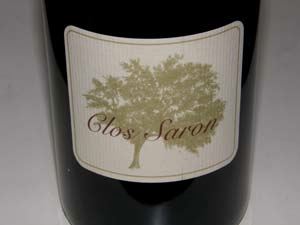 1999 Clos Saron California Pinot Noir 13% alc., 58 cases, $45. Inaugural vintage. · Very good color. Appealing aromas of black raspberries, blackberries, brioche, earth and oak, becoming more fruity over time in the glass. The wine is holding up beautifully with plenty of juicy dark berry fruit, integrated soft dusty tannins, and a good acid lift on the fruity finish. Reminds me of an aged Burgundy 1er. Still drank well the following day from an opened and re-corked bottle. Could go for another 5 to 10 years. An exceptional older Pinot Noir.
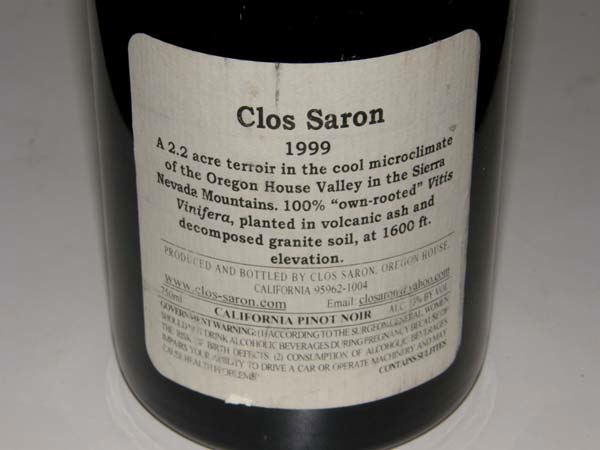
2001 Clos Saron California Pinot Noir 13% alc., 28 cases, $45. · Deep reddish-purple color in the glass. Dark berries and black cherries are the featured fruits with oak, smoke and loamy earth in the background. A bit rugged and still sporting flamboyant tannins, this Pinot drinks more like a Cab. The fruit core is quite tasty, and there is a good spark of acidity on the finish. This wine will benefit from the proper food accompaniment. Good.
2002 Clos Saron Pinot Too California Pinot Noir 13% alc., 30 cases, $25. From young vines in the Home Vineyard. · Moderate reddish-purple color in the glass. The biggest surprise in the lineup. Alluring scents of wild berries, black plum sauce, brier and exotic woods. Tasty core of black raspberry fruit with an underpinning of grilled and smoked meat. Still retaining moderate tannins but smooth and silky in the mouth. My only nit would be a little sharpness on the finish as the brisk acidity surfaces, but this would be easily tempered with the proper food. An impressive young vine wine that has held up nicely. Very good.
2003 Clos Saron Home Vineyard California Pinot Noir 13.3% alc., 31 cases, $45. · Moderate reddish-purple color in the glass. The fruit plays second fiddle to the aromas and flavors of loamy earthy, smoke, tobacco and ash. There is plenty of drying tannins and a bright acid spine. A rustic wine with plenty of heft and a prominent smoky tone throughout. Decent.
2004 Clos Saron Home Vineyard California Pinot Noir 13.3% alc., 32 cases, $45. · Moderate reddish-purple hue in the glass. Aromas of dark berries, crushed rock, Crayola and oak char. Delicious essence of fresh crushed berries that is vivid and intense on the palate and persisting for what seems like a minute on the big finish. Very soft in the mouth with melded tannins. An impressive effort. Very good.
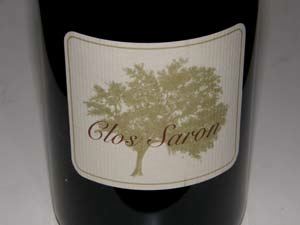 2005 Clos Saron Home Vineyard California Pinot Noir 13.3% alc., 39 cases, $45. · Moderate reddish-purple color in the glass. This wine pleases on every level. The aromas are reminiscent of a fresh berry tart with some floral, mineral, and oak notes in the background. Incredibly delicious core of crushed wild berries, currants and black cherries with a hint of spice and cola. The savory, even exotic, fruit is bright and striking and its taste lingers on the pleasing finish. There is a deft touch of oak and the tannins never intrude on the experience. Still great the next day from a previously opened and re-corked bottle. Trust me, you are going to love this wine.
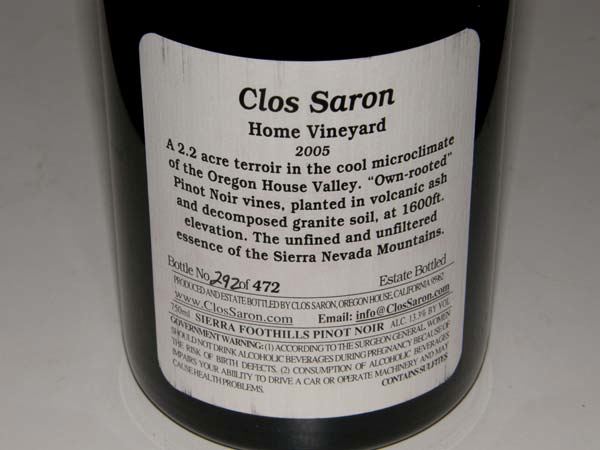
2006 Clos Saron Home Vineyard Sierra Foothills Pinot Noir 13.4% alc., 78 cases, $45. · Medium garnet color in the glass. The nose needs some coaxing in the glass, eventually offering pleasing aromas of blackberries and boysenberries, oak and baking spices. Striking assault of fruit on the mid palate with a potpourri of dark berries, black cherries and cassis with hints of spice, cola and game. Takes on more interest and intensity with time in the glass. A seamless wine with well-proportioned tannins and acidity bringing the fruit to life. Definitely will improve over the next several years.
 2007 Clos Saron Home Vineyard Sierra Foothills Pinot Noir 13.4% alc., 82 cases, $45. · Moderate reddish-purple color in the glass.The nose is very striking and the most flamboyant in this vertical tasting. Profuse aromas of fresh berries, rose petals, and exotic spices are mesmerizing. Intensely fruity with flavors of black raspberries, cassis, olallieberries, Oolong tea, cola and unidentified exotic notes. This is one of those wines that really makes you want to take another sip. Seamless and harmonious in every way. You can drink this wine now for its hedonistic aromas and flavors, but this is one you will want to dance with after more maturation in the bottle. I was stoked over this Pinot.
2008 Clos Saron Home Vineyard Sierra Foothills Pinot Noir 13.5% alc., 70 cases, $45. · This is far too young to drink now, but the potential is obvious. The nose is shy, offering demure cherry and berry fruit aromas with noticeable oak. Darkly fruited with hints of smoked meat, earth and cola. Still closed with oak and tannins swamping the fruit now. If you drink now, decant. This is a twenty year wine. Very good.

Furthermore Wines: On To SomethingFurthermore Wines is a boutique urban winery in San Francisco specializing in small lots of Pinot Noir. The winery was launched by two Pinot Noir lovers, Robert Zeches who is a software engineer currently doing materials science research at University of California at Berkeley, and Chad Richard, a digital media entrepreneur employed by Apple. I first sampled their 2007 and 2008 Pinot Noirs at this year’s Pinot Days in San Francisco and was very impressed. Their wines have garnered considerable interest from the wine press and have won accolades at major wine competitions. I recently tasted their three 2008 releases, and the quality indicates that they are on to something. All three wines show deft winemaking and choosing among them comes down to personal preference.
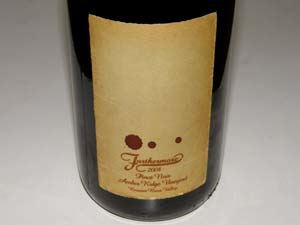 2008 Furthermore Amber Ridge Vineyard Russian River Valley Pinot Noir 14.3% alc., pH 3.66, 75 cases, $39.95. Clones 115, 667 and 777. Aged 12 months in 33% new French oak. · Moderately dark reddish-purple hue in the glass. Restrained but pleasing aromas of strawberries, red raspberries, red cherries, dark chocolate and a hint of barnyard. A charming wine that needs time to open. The red ripe strawberry and raspberry fruit is seductive, accented by pleasing notes of cherry cola, spice and mocha. Impressive aromatic persistence on the finish. Of the three wines, this one evolves more in the glass, is more nuanced, has the most pinotosity, and is the one I prefer. Very good (+).
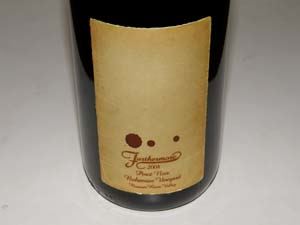 2008 Furthermore Bohemian Vineyard Russian River Valley Pinot Noir 14.2% alc., pH 3.53, 75 cases, $39.95. A very cool vineyard site located in Freestone. Clones 115, 667 and 777. Aged 10 months in 50% new French oak. · Dark reddish-purple color in the glass. Effusive aromas of blackberries, black plums, and Xmas spices. Rustic and earthy with plenty of juicy dark berries, cassis, oak toast and spice flavors. Generous and intense drifting to Syrah in style. Lacks some persistence on the finish. With nicely structured tannins and upfront drinkability, this is a California fruitista wine that will have fans. Good.
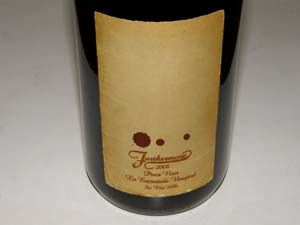 2008 Furthermore La Encantada Vineyard Sta. Rita Hills Pinot Noir 13.8% alc., pH 3.66, 50 cases, $39.95. Organic and biodynamic vineyard owned and farmed by Richard Sanford. Clones 115, 667 and 777. Aged 12 months in 50% new French oak barrels. · Moderately dark reddish-purple hue in the glass. Aromas of dark stone fruits and berries highlighted by oak spice and toast. Tasty core of moderately concentrated dark red and black fruits with an earthy and savory caste, and a refreshing citrus tang on the finish. The enticing and heady fruit is lifted nicely by the acidity and the creamy mouthfeel is appealing. This wine gives you a big charge of fruit and little else, but that fruit charge is delicious. Good (+).
Furthermore Pinot Noirs are sold through a mailing list (www.furthermorewines.com) and online. The proprietors could offer more information on their website, but this is understandable given they have day jobs as well. As the winemakers become more familiar with their fruit sources, the wines will undoubtedly improve, although the initial efforts have been impressive.
OREGON-O8-Oh MyThe 2008 Oregon Pinot Noirs continue to impress for their impeccable balance. If you are of the persuasion that life begins at 14.0 or less, and you love Pinot Noirs that grace the table beautifully, I would suggest that you stock up on 2008 Pinot Noirs from the Willamette Valley. Unfortunately, in many cases you will have to forego immediate pleasure as the wines need some bottle age to show their best. Here are a few 2008 Oregon Pinot Noirs I tasted recently and can highly recommend.
This is the oldest winery in the southern Willamette Valley but a new find for me. The winery and estate vineyard are located on a hillside 15 miles west of Eugene. Winemaker Matthew LaVelle crafts multiple varietals including Willamette Valley Pinot Noir, Dry Rosé of Gamay, Pinot Gris, Riesling, and Gewürztraminer, as well as Columbia Valley Chardonnay, Viognier, Syrah, Cabernet Sauvignon, Merlot and Bordeaux blends. Matthew joined the winery in 2006 and took over as winemaker in 2008, working closely with consulting winemaker Gary Carpenter. Matthew’s father, Douglas LaVelle, founded LaVelle Vineyards in 1994, taking over the existing bonded winery license from Lee Smith (Forgeron Vineyards). In 1998 he opened the LaVelle Wine Bar & Bistro (now known as The Club Room at the Market) at the 5th Street Public Market in downtown Eugene, Oregon where gourmet cuisine is paired with LaVelle wines. The winery is open daily from 12:00 to 5:00 for tasting. The wines are also sold through a mailing list and online (although the online store is not operative when I checked recently). The website is www.lavellevineyards.com.
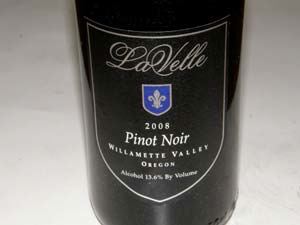 2008 LaVelle Vineyards Willamette Valley Pinot Noir 13.6% alc., 635 cases, $24. · Moderate reddish-purple color in the glass. Great nose that keeps pumping out aromas of Bing cherries and spice. Delicious red berry and cherry fruit core with the slightest note of peppermint. Elegant and harmonious with soft tannins and a refreshing finish showing some persistence of juicy fruit. Highly drinkable now and a great value. Very good (+).
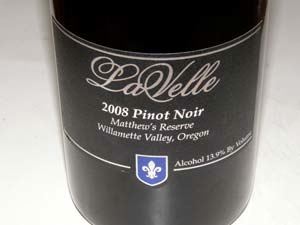 2008 LaVelle Vineyards Matthew’s Reserve Willamette Valley Pinot Noir 13.9% alc., 430 cases, $35.99. The first Reserve Pinot Noir produced since 1998. · Moderate reddish-purple hue in the glass. Somewhat brooding initially but opening nicely with coaxing to reveal an intense perfume of fresh darker berries and cherries with a subtle savory and floral note. More structured and intense than the regular Willamette Valley bottling, with tasty flavors of cassis, black cherry, and anise augmented by a note of loamy earth and oak in the background. The impressive depth of flavors really grabs your attention. Drinks easily now but will be better with another year or two of cellaring. A Pinot that deserves the Reserve designation.
Cornerstone Cellars A collaboration between Cornerstone Napa’s Craig Camp and renowned Oregon winemaker Tony Rynders (formerly the winemaker at Domaine Serene for ten years). Camp developed a passion for Pinot Noir thirty years ago when he began importing the Burgundy selections of Rebecca Wasserman and made frequent trips to the Burgundy estates she was discovering. Together they have released their first Pinot Noir from the 2008 vintage representing a synthesis of each of their perspectives. Camp likes edgy structure and acidity with Rynders leaning more towards richness and depth. Their goal is the combine their preferences to produce a wine with a balance between structure and power while reflecting Oregon terroir. Cornerstone Cellars has found a home in the Willamette Valley, sharing a winery with Rynders just outside of Gaston, where Rynders also makes his own wine under the Tendril label. Visit www.cornerstonecellars.com for further information and to acquire the wine.
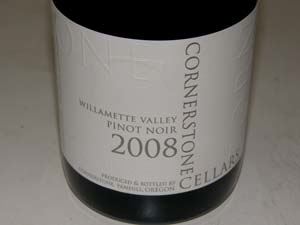 2008 Cornerstone Cellars Willamette Valley Pinot Noir 13.9% alc., 50 cases, $45. 50% Eola Hills AVA and 50% Yamhill-Carlton District AVA. 75% Pommard clone and 25% Dijon 115 clone. Aged 15 months in 50% new and 50% 1-yearold French oak barrels. · Moderately dark reddish-purple color in the glass. Lovely aromas of dark berry jam, spice and roseate potpourri. Delicious essence of darker berry and stone fruits with a note of anise, oak spice and loamy earth. Still has some tannin to shed and isn’t offering all the charm it will in another year or two. Doesn’t yet capture your full attention, but definitely gets a nod. Very good.
Willamette Valley Vineyards This is one of Oregon’s iconic wineries founded by Jim Bernau in 1983 in Turner, Oregon. Today, Willamette Valley Vineyards (WVV) is Oregon’s third largest winery, releasing over 112,000 cases of wine each year, half of which is Pinot Noir. The winery represents the nation’s first successful self underwritten public offering and now has over 4,500 owners. The Estate Vineyard consists of 50 acres planted to Pommard and Wädenswil clones with some blocks grafted over to Dijon clones. In 1997, the winery acquired the Tualatin Estate near Forest Grove which has been updated with newer rootstocks and planting of Dijon clones. All vineyards are LIVE certified. The current winemaker, Forrest Klaffke, with 30 years of winemaking experience followed Joe Dobbes at WVV in 2001. The winery is innovative and progressive. In 2005, they were the first winery to include resveratrol levels on their wine labels. More recently, they became the first winery to use cork stoppers harvested from forest lands certified by the Rainforest Alliance to Forest Stewardship Council. The tasting room sits on a hillside with impressive views (see below) and is open daily. The website is www.willamettevalleyvineyards.com. WVV has an impressive lineup of multiple Pinot Noirs with both the Willamette Valley appellation blend and the Whole Cluster Willamette Valley Pinot Noir made by carbonic maceration in the Beaujolais style solid, dependable, value-priced wines. The three special 2008 vineyard designate wines reviewed below are still very closed. I tasted both wines from an opened and re-corked bottle four days after popping the corks and they were drinking beautifully. I would cellar these wines for at least two years and decant when opened. These wines are not released to general public at this time.
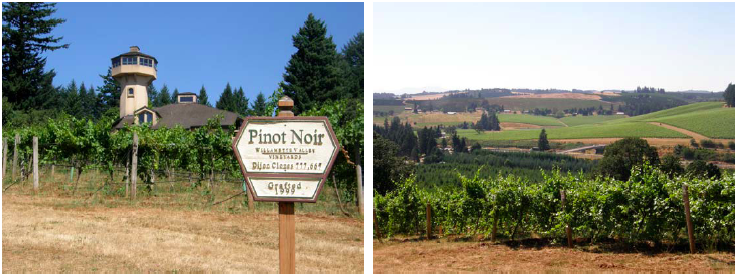
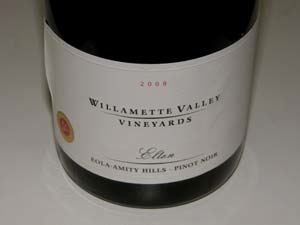 2008 Willamette Valley Vineyards Elton Eola-Amity Hills Willamette Valley Pinot Noir 13.0% alc., 415 cases. From a 60-acre vineyard containing clones 114, 115, Pommard and Wädenswil planted in Jory soil. Aged 14 months in 62% new French oak barrels. An Oregon Certified Sustainable Wine. · Aromas of red berries including strawberries with strong notes of dried oak, straw and mint. Red-fruited and austere at present with a spark of acidity on the hi-tone finish. Soft and elegant. Very good.
2008 Willamette Valley Vineyards South Block Willamette Valley Pinot Noir 13.5% alc., 100 cases. Sourced from the first 15 acres planted by founder Jim Bernau in 1983. The vines are self-rooted and organically farmed. Clones 667, 777, Pommard and Wädenswil clones in Jory soil. Aged 15 months in 47% new French oak barrels. An Oregon Certified Sustainable Wine. · Very slightly corked. Shy cherry and berry fruit aromas with highlights of oak and underbrush. Tasty cherry, cranberry and pomegranate fruits framed by bright acidity evident on the citrus peel-toned finish. Closed and tight but showing promise and will undoubtedly deserve a higher rating in the future. A very slightly faulted wine but still Good.
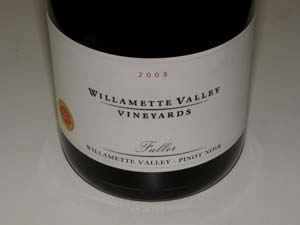 2008 Willamette Valley Vineyards Fuller Willamette Valley Pinot Noir 13.5% alc., 25 cases. From the Tualatin Estate which was first planted by Bill Fuller in 1973. This wine is a tribute to him. Clones are 114, 115 and Wädenswil planted in Laurelwood soil. Aged 15 months in 50% new French oak barrels. · Moderate reddish-purple color in the glass. Shy but pleasing aromas of berry compote, currants, raisins and supporting oak. Impressive core of juicy darker berry fruits framed by bright acidity and wrapped in soft fruit tannins. Discreetly proportioned in body and weight with deft use of oak. Flat out terrific four days later from a previously opened and re-corked bottle. A very special collectable wine that will reward the patient.
Pinot Briefs
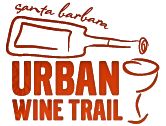 Downtown Santa Barbara Wineries There are a cluster of 11 wineries within blocks of downtown Santa Barbara, many of which are clustered in an area known by locals as the Funk Zone. The wineries have created the Santa Barbara Urban Wine Trail to encourage locals and visitors to Santa Barbara to explore the wineries on foot. Pinot Noir producers include Carr Vineyards and Winery, Oreana Winery, Santa Barbara Winery, Summerland Winery and Whitcraft Winery. Visit www.urbanwinetrailsb.com. Randall Grahm Revisits Pinot Noir According to a recent article in the San Francisco Chronicle by Jon Bonné, Randall Grahm of Bonny Doon fame has embarked on a new project at his newly acquired vineyard just outside San Juan Bautista in California. He is planting a small amount of Pinot Noir along with other grapes including Grenache. The vines will be head pruned and dry farmed and Grahm plans to cross-pollinate the vines, then plant the seeds that result to create all new grape varieties. The experiment is risky and will take years to complete, but could result in a whole new group of grape breeds unique to the site. Deep Roots Coalition This organization, known as DRC, and not to be confused with that other DRC in Burgundy, was formed in 2003 by John Paul of Cameron Winery and Russ Raney of Evesham Wood Vineyard. The twelve current members of the group adhere to dry farming practices. The members feel that dry farmed wines are not necessarily better, but are more distinctive and more reflective of their terroir. Current coalition members include Ayres Vineyard, Belle Pente, Brick House Vineyards, Cameron Winery, Crowley Wines, Evesham Wood Vineyard, The Eyrie Vineyards, J. Christopher Wines, Matello Winery, Patricia Green Cellars, Thomas Winery, and Westrey Wine Company. Interest in this movement should increase as more concern arises among winegrowers over the projected shortage of water in the coming decades. WineryTweets.com This site lists winery Twitter and Facebook URLs for 750 United States wineries sorted alphabetically and by region. WineryMailingLists.com has 713 wineries with mailing lists sorted alphabetically and regionally. Included are lists of wineries that only accept waiting list members (“The Waiting Game”) and wineries that do not accept names for wine allocations or wait list (“No Game”). There is also a “Money Makers” section which compares the wine release price with the current street price for selected wines. Visit www.winerytweets.com and www.winerymailinglists.com.
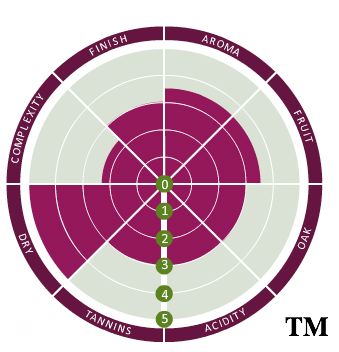 WineMatch.com This is said to be a consumer-friendly concept in the evaluation of wines called “Wine Profiling.” It is a data-based driven, wine matching engine using more real data and less subjectivity. Wines are not judged on a 100-point scoring system, but instead, wine qualities are presented by highlighting intensities of wine characteristics on a wheel known as the WineMatchWheel™. Wines submitted by wineries (only United States wines are accepted) are profiled and lab chemistry performed in a calibrated and verified wine lab using industry standards. This data is then combined with data provided by wineries. This fall there will be mobile apps available. When I visited the website, www.winematch.com, I found the information available no different from the data provided on winery websites through their “tech sheets,” and the usual winemaker notes were prominently displayed. The site claims to reduce subjectivity, yet the WineMatchWheel™ contains a subjective estimate of a wine’s fruit, the wine’s complexity, finish, oak, tannins and aroma. I don’t find anything revolutionary in his site but applaud the absence of 100-point scoring and the attempt to give the consumer a better understanding of the characteristics of a given wine. Aubert Wines Buys New WineryMark and Teresa Aubert have bought a new winery, located at 333 Silverado Trail in Calistoga, California, to house Aubert Wines. The Auberts, who produce Chardonnay and Pinot Noir from single vineyard sites in Sonoma County, will move into their 8,000 square foot winery in January 2011, and Aubert customers will have an opportunity to visit in late fall 2011. Series of Articles on How to Build a Wine Cellar A useful 6-part series of articles on building your home wine cellar: www.snooth.com/wine-cellars/building-a-wine-cellar/. I’m tempted. The Flip Side of Phyllis Gillis A humorous and spicy tale about the “off-road detours of Phyllis Gillis in a lifetime of rolling Plan B’s.” Phyllis was previously Executive Director of the Carneros Wine Alliance and is a noted author of several books. The Flip Side is a well-written tale about “becoming Phyllis Gillis” offered in monthly installments. You will get a laugh out of this. Visit www.phyllisgillis.com. Burgundy-Report Bill Nanson lives in Europe and visits Burgundy frequently. His free quarterly reports at www.burgundy-report.com are well worth reading. The author has posted since late 2002 with a slowly expanding library of domaine and village profiles, comments on the Burgundy market and vintage challenges, and a discussion of the wines of Burgundy. The site includes tasting notes for many bottles of great Burgundy and there is opportunity to discuss the reviewed wines with others through the Burgundy Forum. The photographs of Burgundy are exquisite. The latest summer edition is all about Beaune.
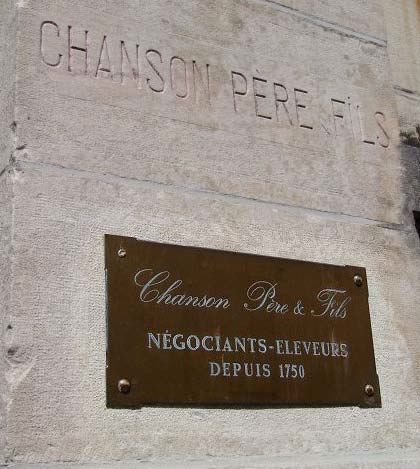 Sta. Rita Hills Chardonnay Followup Reader Russell McCandless chimed in on my recent article extolling Sta. Rita Hills Chardonnays. He said, “Oh, you are so spot on. The best New World Chardonnay I have ever had was a Longoria Mt. Carmel Vineyard Chardonnay from some time in the early 2000s. The Sea Smokes are treasures of my cellar and have blown away friends for whom nothing but Cote d’Or white Burgundy will do. The secret is that these are big in-your-face Chardonnays BUT THE’RE BALANCED, which is the secret. Year in year out I like the Longoria Cuvée Diana as well as or better than any other California Chardonnay. My experience with California Chardonnays has not been pox-free, but my pox experience with white Burgundy has been at least as bad or worse.” As a side note, Wallys Wine and Spirits in West Los Angeles (www.wallywine.com) is offering a custom blend of Sta. Rita Hills Chardonnay from Mount Carmel and Gnesa Vineyards made by Brewer-Clifton. The 2009 Brewer-Clifton Cuvée Blanche Chardonnay is $39.99. Celebration of Harvest On October 9, 2010, over 100 Santa Barbara County vintners will gather on the grounds of Rancho Sisquoc Winery in the Santa Maria Valley to pour their latest offerings. Local restaurants and specialty food purveyors will feature their talents, live bands will perform, and a silent auction filled with large format bottles will benefit local food banks. Tickets are $65 in advance at www.sbcountywines.com. All Purpose Glass from Riedel The Vinum XL is styled similar to the Oregon Pinot Noir glass introduced a few years ago with a slightly narrower top and has the blessings of Richard Geoffroy, the winemaker for Dom Pérignon, who prefers it for his Champagnes. I have come to use the Reidel Oregon Pinot Noir glass for Champagne, Chardonnay and Pinot Noir. This Riedel Vinum XL glass almost seems antithetical as the company has always been a proponent of a different style of stem for every variety of wine.
NewAir Thermoelectric Wine Cooler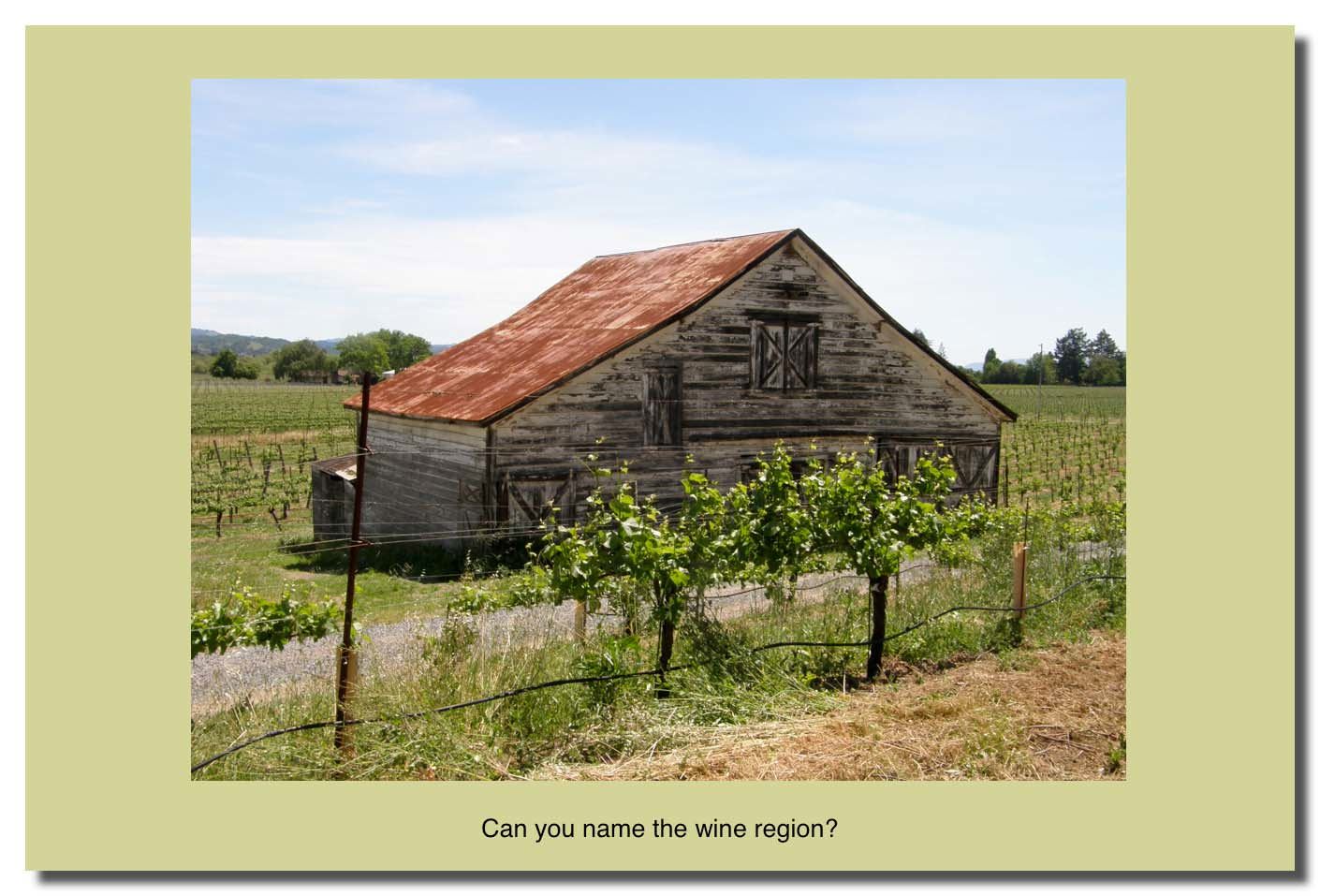 I do not usually endorse wine related items but after evaluating this unit for NewAir, I felt it was worthy of your interest. The NewAir AW-180E thermoelectric wine cooler is sleek in design, has five chrome-plated shelves and holds 18 standard bottles of wine. Temperature is controlled by push buttons on the front and the temperature is digitally displayed. An interior blue LED light adds a dramatic effect to display the wine collection inside. Because it uses no ozone-depleting chemicals, the unit is ecologically friendly and with few moving parts, there is minimal vibration. Operation is continuous but very quiet. The unit is light in weight and can easily be moved around the house. It will fit nicely under a counter. Similar, but larger NewAir coolers are offered that hold 28 and 32 bottles. The largest unit has two independently controlled temperature zones. My only complaint with this unit is the same grip I have with my own 700-bottle Vinotheque wine cooler: large Pinot Noir bottles and Champagne bottles either do not fit into the racking, or if forced into the racking, rip the labels apart. The NewAir unit does accommodate half bottles, which fall through the racking I have on the Vinotheque cooler.
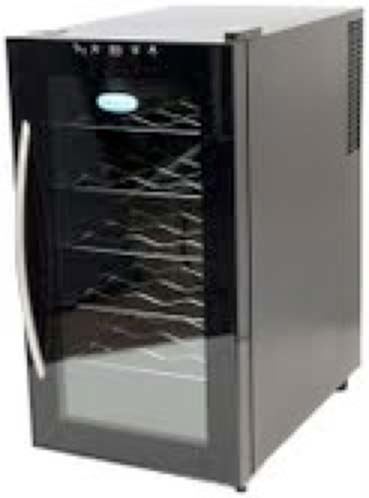 The NewAir AW-180E unit pictured is offered by Air & Water Inc., and is priced at $145.99, but you can save $10 by entering the Discount Code ANW100 at the website, www.air-n-water.com by September 30, 2010. |